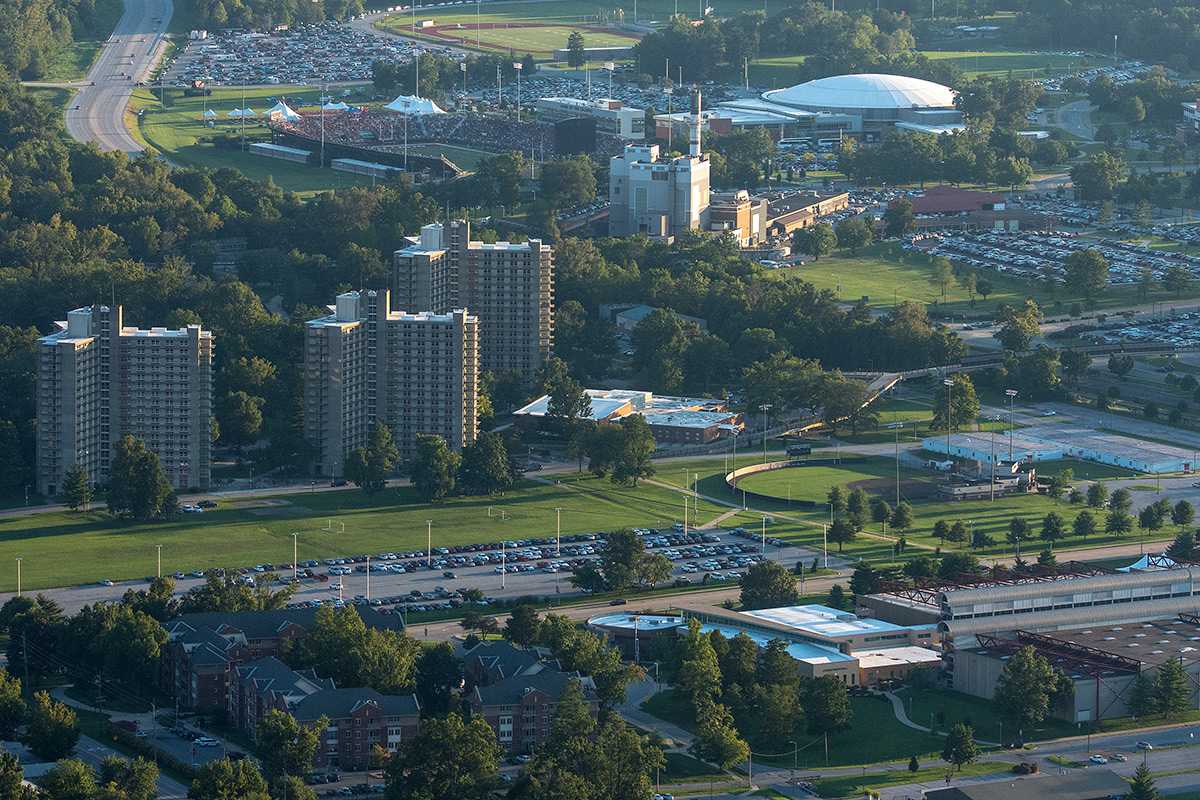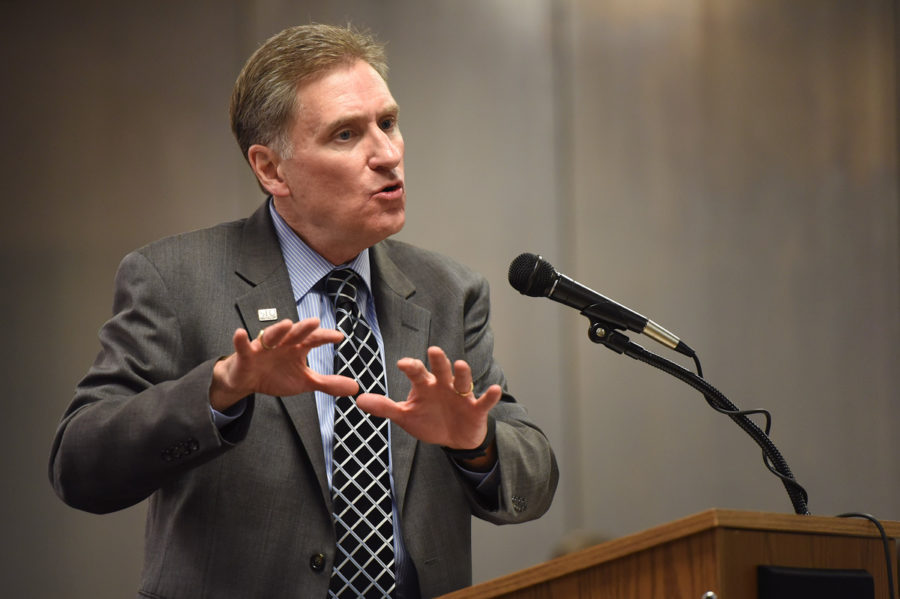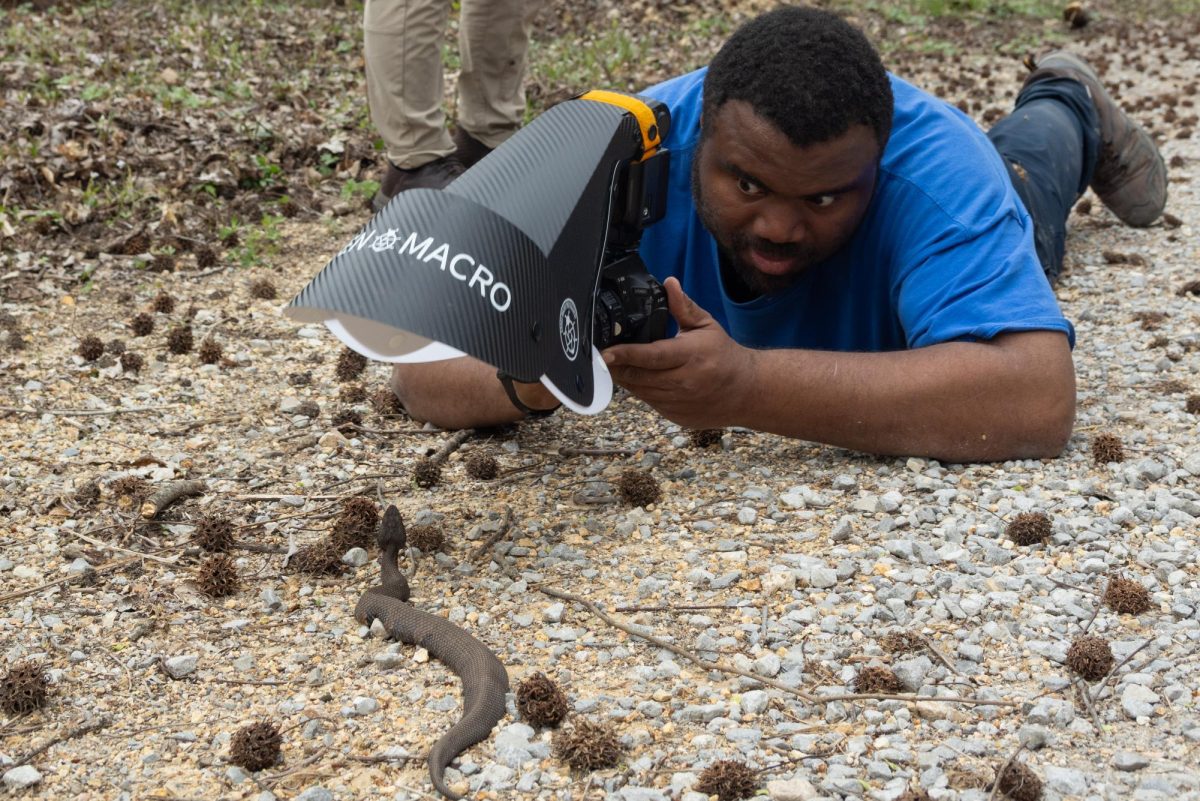‘As the university goes, the region goes’: Officials stress economic impact SIU has on southern Illinois
April 21, 2017
University leaders and city officials testified Thursday in front of an Illinois House committee, painting a grim image of how the state budget impasse is affecting SIU and the southern Illinois economy.
During the hearing at the Dunn-Richmond Economic Development Center, SIU President Randy Dunn said as the largest employer in southern Illinois, the university provides the region with services in social work, healthcare, legal support, K-12 partnerships and other resources.
Describing the university as the “most powerful steward in this region,” Dunn said SIU is connected with the quality of life in southern Illinois. Now, those services are declining and disappearing. Without them, the southern part of the state will suffer, Dunn said.
Advertisement
“Here, as the university goes, the region goes,” he said.
Since June 2015, the Carbondale campus has made $21 million in cuts as a result of the state budget impasse, now in its 22nd month. These reductions were made by freezing hires, not buying equipment and reducing regional work, including other things, Dunn said.
Asked by state Rep. Christian Mitchell, chairman of the Economic Opportunity Committee, what else can be reduced from the university’s budget, Dunn said there really is nothing more to cut.
“There is nothing else to pluck off at this point,” the system president said. “All the low hanging fruit, all of the fat on the bone is gone.”
Administrators are now preparing for more severe reductions that will end some campus operations, academic programs and critical student and regional services.
In late March, Dunn announced his plan for the campus to cut at least $30 million in spending from its $450 million budget. During the committee meeting, Dunn said these cuts ensure SIU remains sustainable, viable and open. However, he said, the university will look like a “very different institution than what is needed to serve 66 counties of central and southern Illinois.”
Shortly after the announcement, interim Chancellor Brad Colwell, who is a finalist for the permanent chancellor position, said the changes at the university will be “challenging and painful” and “almost certainly include layoffs.”
Advertisement*
One of the critical student services at risk of losing state funding is the university’s Counseling and Psychological Services, Dunn said. In a previous interview, Jaime Clark, the center’s director, said the loss of that funding “would be catastrophic” and either force drastic reductions to its services or introduce a student fee.
The service is one of 15 centers or initiatives a non-instructional prioritization committee on campus suggested could be cut off from funding if the university receives no state appropriations by the end of the fiscal year. Others include WSIU Public Broadcasting, the University Press and Touch of Nature.
Another, the Office of Economic and Regional Development, which has helped nearly 3,000 people with their business development in the last decade, could shut down if state support is eliminated. During the last 10 years, the center has helped start or expand 504 businesses.
Kyle Harfst, the center’s executive director, testified in front of the committee Thursday. He said the Small Business Development Center, which was created through the economic development office to promote the economic well-being of the region, once had a staff of 11, including graduate assistants. It now staffs two people.
Dunn used the University Museum as an example of a unit that provides quality of life to community members. The museum once provided more educational programs and support to the community than it does now; summer programs hosted 12,000 to 16,000 school kids from the region who may have otherwise never seen a museum.
“That’s all done. It’s gone,” Dunn said.
The museum was stripped of its accreditation in February, and the non-instructional prioritization committee has proposed cutting more than $255,000 from its budget.
State Rep. John Cavaletto, who earned his bachelor’s and master’s from SIUC, said he was saddened by Dunn’s testimony. Citing U.S. Census data, Cavaletto said the state needs more jobs and taxpayers. In 2016, Illinois lost more than 37,000 residents, the most of any state for the third consecutive year.
“We need this university here,” said Cavaletto, R-Salem. “If you’re not growing, you’re dying.”
Asked about administrative costs, Dunn said it is low compared to other institutions and the university is considering reorganizing departments to cut down more on that spending.
‘The impacts are real’
Carbondale Mayor Mike Henry said he knows legislators in Springfield who think the state won’t see a budget until 2020 — something he called “unconscionable.”
Henry said while he has watched enrollment fall at the university in recent years, the state’s budget crisis is contributing to the lack of students in Carbondale. He said officials are unsure where the bottom is for enrollment, and his gut tells him it will dip again in the fall.
Enrollment at the campus peaked in fall 1991 when it totaled 24,869. But during the last two decades, SIUC has seen a generally consistent decline in students. In fall 2016, enrollment hit its lowest point since 1965.
Dunn, citing a nationwide study, said each student contributes about $6,000 annually to the local economy. About 15 percent of students can spend up to $18,000. This means students contribute tens of millions of dollars to the local economy each year.
But when Henry talks with parents of prospective students, they worry and ask if the program their children plan to go into will still exist before they graduate. Dunn said this is the first question the university’s administrators get as well.
“Our answer is absolutely yes,” Dunn said, reiterating that the university teaches out programs. “Do not bat an eye about it.”

Henry said SIU’s enrollment has also taken a blow from the University of Illinois’ decision to lower its standards for ACT tests. He said U. of I. gets special funding from the state that other universities don’t receive, and accused leaders in Springfield of “trying to break the university system in Illinois and get rid of it.”
Henry also said house prices in Carbondale are in the tank and dropping. He said one of his friends bought a home in the city six years ago for $400,000. The mayor described it as a “beautiful, beautiful home.” It’s been on the market for two years, and is now listed for $259,000.
“It’s coming from the dysfunctionality of the state of Illinois,” he said.
For nearly two years, Republican Gov. Bruce Rauner and Democrats who control the state Legislature, including House Speaker Michael Madigan, have not been able to pass a state spending plan.
Mitchell, D-Chicago, said he has spent those two years talking with students and administrators around the state about the permanent damage done by the budget crisis. From what he has been told, the best faculty are fleeing Illinois and universities are struggling to recruit students, even from their own backyards.
“Our No. 1 competitors aren’t Indiana or Wisconsin or Missouri; our No. 1 competitor is nowhere university,” he said. “These are kids in Illinois who simply aren’t going to college.”
Mitchell described higher education institutions as the steel mills and automobile plants of the towns in which they are located. When they lose money, he said, they hire fewer people, who buy less food from the local grocer and butcher. Former employees can no longer pay their mortgages. Home values drop. School districts have less money and as enrollment declines, businesses lose out on a skilled workforce.
“The impacts are real and they are direct on the lives of real people,” he said.

Dunn said the SIU system is the second largest employer in the state south of Springfield, behind Scott Air Force Base. But in the last decade, the campus has seen a loss of hundreds of employees and in part, has reduced millions of dollars in payroll to those living in Jackson County, he said.
Citing a university study from 2011, Dunn said every dollar spent by SIU — which, including its healthcare, has a roughly billion dollar system budget — turns over eight times. This, Dunn said, allows SIU employees to provide economic growth and build a region.
In addition to the state’s financial crisis, money needed to repair and renovate parts of the infrastructure on campus has increased from about $500 million to more than $770 million in the last eight years.
‘The engine of economic growth’
A university study in 2011 found that SIU contributes significantly to the economies in southern and central Illinois.
Each year, the campus contributes about $2.3 billion in “economic activity” to the state’s economy. It also directly and indirectly supports nearly 2,400 jobs and almost $1.2 billion in personal income. And for every dollar appropriated by Illinois to the campus, nearly $8 of economic activity is generated in the state.
The research study, which described the university as the “engine of economic growth” in southern Illinois, was authored by Harfst, a graduate student and Subhash Sharma, chairman of the Department of Economics.
The researchers also found that:
- Of SIUC’s nearly 210,000 alumni at the time, more than 104,600 lived in Illinois and contributed $17.4 billion annually to the state’s economy.
- Each year, the campus contributes more than $8 billion in “increased expected work life earnings” for its graduates.
- Forty-one cents of every dollar appropriated by the state to the campus is returned to local or state governments in tax revenues.
A plunge in state support
A report released Thursday found that from 2015 to 2016, Illinois cut funding for public universities by a “staggering” 80 percent per full-time equivalent student, from $10,986 to $2,196. Oklahoma saw the second-highest reduction in this category at about 12 percent.
The report, produced by the State Higher Education Executive Officers Association, found that nationwide public support for higher education in 2016 fell by 1.8 percent per full-time equivalent student enrollment. However, if it excluded Illinois in its analysis, public funding would have increased by 3.2 percent.
Total revenue per student would have also increased without Illinois. The report found that overall revenue per student, from appropriations and tuition, remained flat at $13,192. But without Illinois, that figure would have increased by 2.6 percent.
Hours after the committee meeting, a national credit rating agency, Standard & Poor’s, dropped SIU’s rating three notches — from “BBB” to “BB.” The announcement came two days after Moody’s Investors Service said it is considering downgrading credit rating at six public universities in Illinois, including SIU.
But if it weren’t for SIU and the jobs it supplies, George Sheffer, president of Murdale True Value, said he would not be able to offer the kind of services he does. Without the university, businesses in town would be “in dire, dire straits,” he said.
Sheffer said he doesn’t want businesses to leave Carbondale like they have in Cairo, and pleaded with Cavaletto and Mitchell to help pass a state budget.
“I’m begging you guys as much as you possibly can to get together and to pull this together right away,” he said of passing a state spending plan. “Forget your bickering and arguing. … This community is feeling pain everywhere.”
Staff writer Luke Nozicka can be reached at 618-536-3325, lnozicka@dailyegyptian.com or on Twitter @lukenozicka.
To stay up to date with all your SIU news, follow the Daily Egyptian on Facebook and Twitter.
Advertisement










